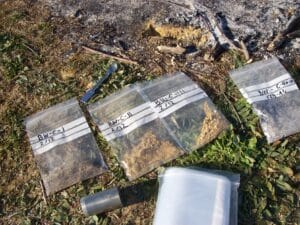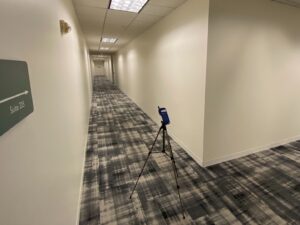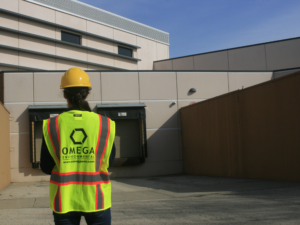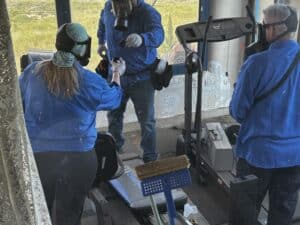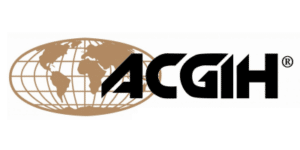Dry Down Activity in Hotel Buildings: How To Prevent Moisture and Mold Damage
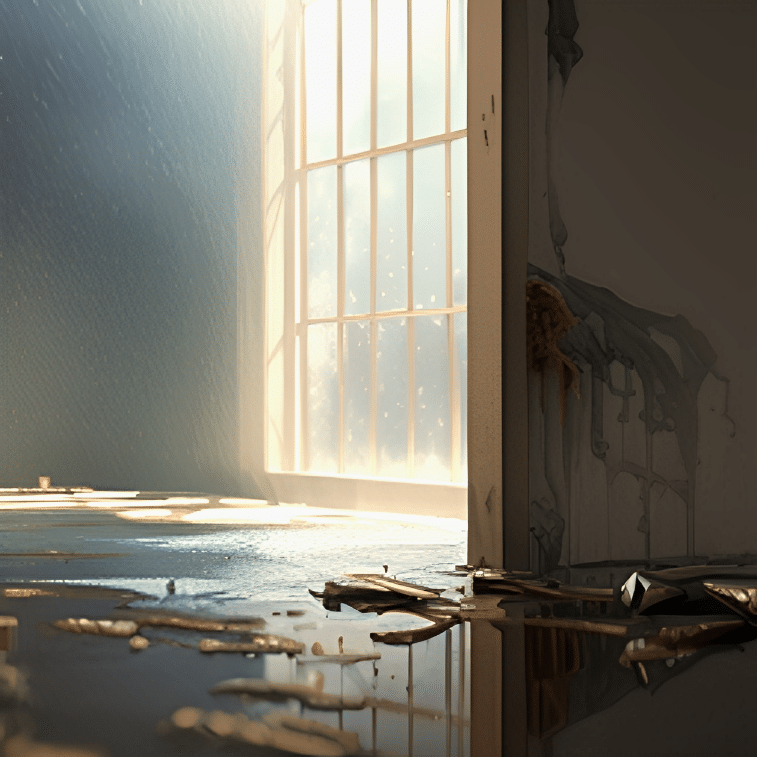
Managing construction activity on a hotel property is already a highly complex operation without the presence of mold. But once excess moisture has made its way into a building space, it creates an ideal environment for mold to grow, posing a risk to contractors, hotel employees, and guests, and adding millions of dollars in abatement costs. The presence of mold is enough to stop hotel construction – whether it’s a full-scale renovation or a simple remodeling project – dead in its tracks.
Excess moisture has the opportunity to accumulate in multiple building areas of a hotel, and some of the causes are benign and difficult to address without affecting hotel guests.
The Common Causes of Mold and Moisture in Hotels
In comparison to other commercial building types, many spaces within hotel buildings are prone to generating excessive moisture. Moisture and mold can lead to airborne spore contamination in one area of a building, spread through air ducts, and possibly contaminate the air quality throughout an entire structure.
- Guest Showers: Hotel guests take showers in their rooms, and the steam generated during these showers can introduce moisture into the bathroom area. If the bathroom lacks proper ventilation or if guests do not use exhaust fans, the moisture can linger and create an environment conducive to mold growth.
- Swimming Pools: Hotels often feature indoor or outdoor swimming pools. Evaporation from pool water can increase indoor humidity levels in nearby areas. Without effective dehumidification and ventilation systems, this can lead to elevated moisture levels and mold problems.
- Laundry Facilities: Hotels have on-site laundry facilities that generate heat and moisture. If not adequately ventilated, these areas accumulate moisture, making them susceptible to mold growth.
- Poorly Maintained HVAC Systems: HVAC systems that are not well-maintained may not effectively remove moisture from the air. In fact, they can distribute moisture throughout the building, particularly if there is a malfunction in the system or if filters are dirty. This can exacerbate moisture problems and contribute to mold growth.
- High Occupancy and Frequent Guest Turnover: High occupancy and frequent guest turnover mean more people are using showers, HVAC systems, and other facilities that generate moisture. This continual moisture input can make it challenging to maintain appropriate humidity levels.
- Bathrooms and Kitchens: Hotel rooms typically include bathrooms, and some may also have kitchens or kitchenettes. These areas are inherently prone to moisture, with sinks, faucets, showers, and cooking activities all contributing to humidity. Poor ventilation in these spaces can lead to mold growth.
- Indoor Pools and Spas: Hotels with indoor pools and spa facilities can face high humidity levels in these areas. If not well-ventilated and dehumidified, mold can develop on walls, ceilings, and other surfaces.
- HVAC and Duct Systems: HVAC systems can be a source of moisture problems if not properly maintained. Condensation can form in ducts, especially in hot and humid climates, and if not addressed, this moisture can contribute to mold growth.
- Water Leaks and Plumbing Issues: Water leaks from pipes, fixtures, or roofing can introduce water into the building structure. If these issues are not promptly resolved, the moisture can seep into building materials and create an environment where mold can thrive.
- Room Occupancy Patterns: Hotels may have rooms that remain vacant for extended periods, especially during off-peak seasons. Unoccupied rooms may lack temperature control and ventilation, allowing moisture to accumulate, which can lead to mold growth.
- Climatic Conditions: The geographical location and climate of a hotel play a significant role in moisture and mold issues. Hotels in regions with high humidity, frequent rainfall, or extreme temperature fluctuations may be more susceptible to moisture problems.
Hotels are at risk for moisture and mold issues due to a combination of factors. Effective moisture control measures, such as proper ventilation, dehumidification, routine maintenance, and prompt response to leaks or water damage, are essential to prevent and mitigate these problems.
But before workers can commence dry down activity, an experienced environmental consultant who specializes in mold remediation should conduct a comprehensive moisture and mold assessment.
Why Conducting a Moisture and Mold Assessment Benefits Hotel Guests and Employees
While hotel staff may be vigilant for visible signs of moisture or mold, it’s often best to engage a professional mold remediation specialist or environmental consultant such as Omega Environmental Services. We have the expertise and equipment to conduct a thorough assessment that evaluates the extent of mold and moisture in any type of hotel space.
A moisture and mold assessment involves a series of inspections and evaluations that will help determine project scope and budget. It will also help determine if there are areas of the hotel requiring immediate closure to the public.
After any mold remediation is complete, conduct a follow-up assessment to ensure that the problem has been resolved and that there is no recurring mold growth.
A full moisture and mold assessment helps determine the scope of the mold growth in the affected building spaces and evaluate whether excess moisture is generating in seemingly unaffected areas of the hotel. An assessment is a preventive measure that protects the health of hotel guests and employees from potential mold exposure. It is an important first step to take before the drying out process begins.
Drying Out Hotel Buildings: A Step-By-Step Breakdown
- Structural Drying: Moisture can weaken building materials like drywall, wood, insulation, and concrete. Prolonged exposure to moisture can lead to structural damage, warping, and deterioration. Drying these materials helps preserve the structural integrity of the building. If necessary, an opening or hole may be drilled into walls to drain standing water in a wall cavity or to allow air flow. This is typically done in combination with a dehumidifier or blower fan to ventilate the affected areas efficiently.
- Water Extraction: Begin by removing any standing water or excess moisture from the affected areas. This can be accomplished using water extraction equipment, such as pumps or wet/dry vacuums. Ensure that you remove as much water as possible to expedite the drying process.
- Dehumidification: Implement dehumidification equipment, such as commercial-grade dehumidifiers. Dehumidifiers work to extract moisture from the air and accelerate the drying process. Place them strategically in the affected areas to maximize their efficiency.
- Air Circulation: Use air movers, also known as blower fans or air circulators, to facilitate the movement of air within the space. Proper air circulation helps to distribute dry air throughout the area and encourages the evaporation of moisture from surfaces.
- Moisture Monitoring: Continuously monitor the moisture levels in the affected areas using moisture meters and other measuring devices. Regular measurements help ensure that the drying process is progressing effectively and that no areas are overlooked.
- Remove Damaged Materials: Any materials that cannot be adequately dried, salvaged, or cleaned should be removed. This includes items like drywall, insulation, or wooden beams that are extensively damaged or showing signs of mold growth. Prompt removal of damaged materials is essential to prevent further issues. Drywall and wooden beams may need to be remediated if black patches appear in cracks or on plaster or if the wood has become bent, curved, or warped after water damage.
- Cleaning and Disinfection: Clean and disinfect the affected areas once they are thoroughly dried. This step is especially important if the moisture issue resulted from contaminated water sources, such as sewage or floodwater. Cleaning helps prevent the spread of contaminants and promotes a safe environment.
- Water Damage Restoration: After the drying and cleaning processes are complete, undertake any necessary repairs and restoration work. This may involve replacing drywall, insulation, and other building materials. Ensure that the affected areas are restored to their pre-damage condition.
- Mold Prevention: To prevent mold growth, ensure that the moisture levels are maintained within an acceptable range (typically 30-50% relative humidity). Address any potential sources of moisture or leaks promptly to prevent future issues.
- Final Inspection: Conduct a final inspection to verify that all areas are dry, clean, and free from mold growth. It’s important to confirm that the space is safe for occupancy.
- Record-Keeping: Maintain detailed records of the entire drying and restoration process, including photographs, measurements, equipment usage, and any materials removed and replaced. This documentation can be valuable for insurance claims and future reference.
The goal with a successful dry down is to restore the building to a safe and habitable condition while preventing long-term problems like mold growth and structural damage.
A Successful Dry Down Begins With an Experienced Environmental Partner
Omega Environmental Services, Inc. developed a work plan for the dry-down of a moisture impacted office space in Arcadia, California. The work plan was developed by our Certified Industrial Hygienist (CIH) and consisted of a series of important steps, including isolating the 2,500-square-foot office space and setting up dehumidifiers, blower units, and critical barriers in the office space to dry-down the moisture impacted walls. For confirmation testing, a post-visual assessment was conducted after sufficient dry-down of the impacted area. The assessment included the use of an infrared (IR) thermal imaging camera and a moisture meter (MM).
A professional environmental partner can assist in reducing and avoiding potential moisture and mold hazards with a dry-down activity. A fast and rapid assessment and remediation (if needed) are necessary to prevent significant damage to the drywall or inside wall cavities. Omega’s experts can identify the source and extent of moisture and water contamination and provide targeted solutions to mitigate these sources, as well as remediate the effects of moisture and mold on building materials.




